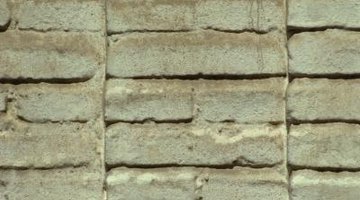Solutions for Calcification on Brick Homes
The calcification that shows up on brick homes is caused by water that soaks into the brick, which dissolves salts that are naturally present in the mud used to create bricks. The salts migrate to the surface of the brick as the water evaporates and, when the water completely disappears, the salts are left behind on the surface. The technical name for this chalky substance is efflorescence, and it can be brown, green, white or yellow depending on the salts that are dissolved in the brick.
Stop the Water Source

Brick can be exposed to water when it rains, but efflorescence that is especially noticeable in one spot is probably caused by a water leak from a pipe. Have a plumber check for a leak in that spot, and be sure to get it repaired before taking action to remove the calcification. You may also notice that efflorescence shows up in a spot where a lawn sprinkler is spraying water on the brick. Place a water guard on the sprinkler to block it from doing this.
Seal the Brick
The only way to completely prevent calcification on bricks is to keep them from being exposed to water. Because the exterior of a house will be exposed to water in damp weather, the best way to prevent that water from being absorbed by the brick is to apply a sealer. Be aware that if brick that has been sealed somehow absorbs water, either from a leak or from a patch of brick that was not fully sealed, that layer of sealer can hold water into the brick and not allow it to escape. That moisture can damage the brick structurally if it is not able to dry out fully.
Clean the Efflorescence
Another way to deal with brick calcification is to clean the brick surface. This is traditionally done by scrubbing the brick with a wire brush to remove any large chunks of salt. Then, a 1:10 solution of muriatic acid dissolved in water can be used to wash the salt away. You will also see results if you clean the brick with a commercial cleaner designed to remove mineral deposits such as CLR or Lime Away.
Is Calcification Dangerous?
Calcification on bricks does not indicate that they are losing their structural integrity or that there is something wrong with your bricks. In fact, some brick buildings that have stood for hundreds of years have significant calcification with this patina viewed by some as adding to the beauty of the structure. Removing calcification is an aesthetic choice, and there is nothing wrong with choosing to leave your bricks alone and not remove the calcification.
References
Writer Bio
Stella Noble began writing professionally in 2004. She received her Juris Doctor from Georgetown University and also holds a Bachelor of Arts in anthropology.
Photo Credits
- Jupiterimages/liquidlibrary/Getty Images
More Articles



